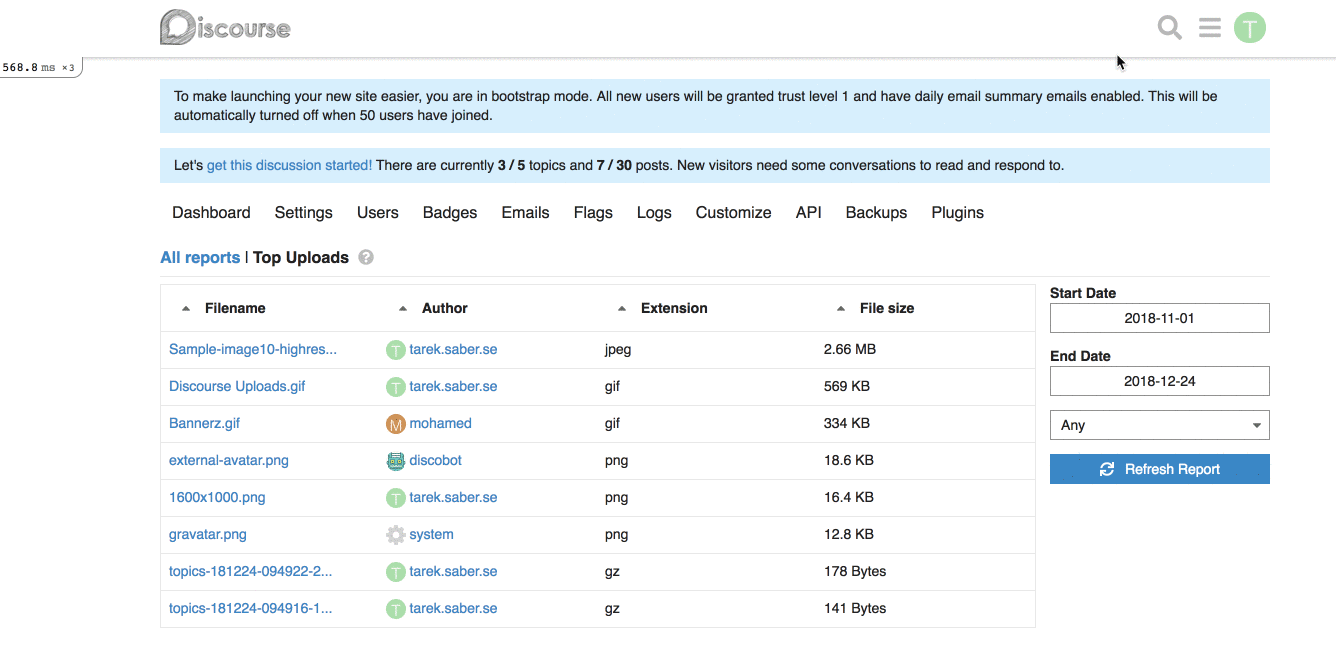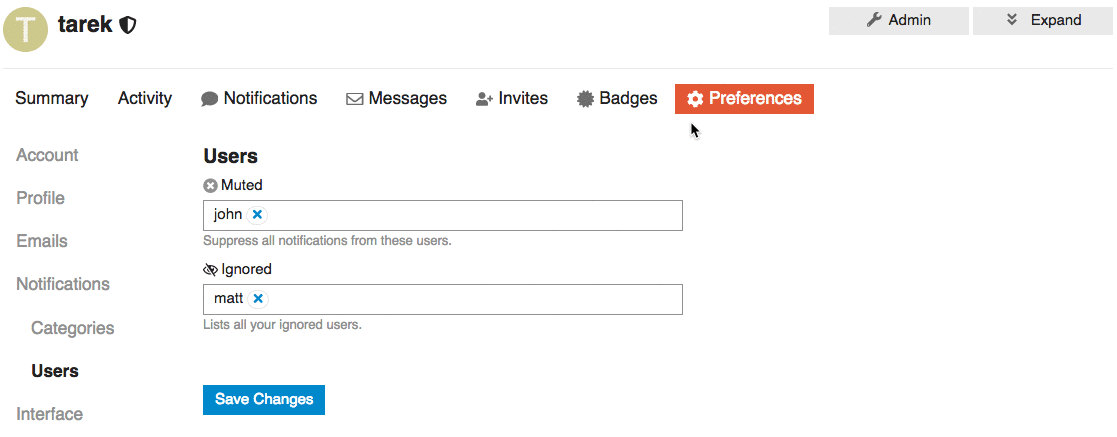* improved emoji support
- always optimize images as part of the task
- use the unicode standard ordering/naming for sections
* UX: more height for when there are recently used
Migrates email user options to a new data structure, where `email_always`, `email_direct` and `email_private_messages` are replace by
* `email_messages_level`, with options: `always`, `only_when_away` and `never` (defaults to `always`)
* `email_level`, with options: `always`, `only_when_away` and `never` (defaults to `only_when_away`)
* FEATURE: Exposing a way to add a generic report filter
## Why do we need this change?
Part of the work discussed [here](https://meta.discourse.org/t/gain-understanding-of-file-uploads-usage/104994), and implemented a first spike [here](https://github.com/discourse/discourse/pull/6809), I am trying to expose a single generic filter selector per report.
## How does this work?
We basically expose a simple, single generic filter that is computed and displayed based on backend values passed into the report.
This would be a simple contract between the frontend and the backend.
**Backend changes:** we simply need to return a list of dropdown / select options, and enable the report's newly introduced `custom_filtering` property.
For example, for our [Top Uploads](https://github.com/discourse/discourse/pull/6809/files#diff-3f97cbb8726f3310e0b0c386dbe89e22R1423) report, it can look like this on the backend:
```ruby
report.custom_filtering = true
report.custom_filter_options = [{ id: "any", name: "Any" }, { id: "jpg", name: "JPEG" } ]
```
In our javascript report HTTP call, it will look like:
```js
{
"custom_filtering": true,
"custom_filter_options": [
{
"id": "any",
"name": "Any"
},
{
"id": "jpg",
"name": "JPG"
}
]
}
```
**Frontend changes:** We introduced a generic `filter` param and a `combo-box` which hooks up into the existing framework for fetching a report.
This works alright, with the limitation of being a single custom filter per report. If we wanted to add, for an instance a `filesize filter`, this will not work for us. _I went through with this approach because it is hard to predict and build abstractions for requirements or problems we don't have yet, or might not have._
## How does it look like?

## More on the bigger picture
The major concern here I have is the solution I introduced might serve the `think small` version of the reporting work, but I don't think it serves the `think big`, I will try to shed some light into why.
Within the current design, It is hard to maintain QueryParams for dynamically generated params (based on the idea of introducing more than one custom filter per report).
To allow ourselves to have more than one generic filter, we will need to:
a. Use the Route's model to retrieve the report's payload (we are now dependent on changes of the QueryParams via computed properties)
b. After retrieving the payload, we can use the `setupController` to define our dynamic QueryParams based on the custom filters definitions we received from the backend
c. Load a custom filter specific Ember component based on the definitions we received from the backend
* FEATURE: Add ignored user list to the User's preference page
## Why?
Part of: https://meta.discourse.org/t/ability-to-ignore-a-user/110254
We want to add list of Ignored users under or along with the muted users preferences section.
This way Users can find and update their list of ignored users.
## UI

## Open questions
Two of many options to represent a list of ignored users is that we can:
1. We can represent the ignored user list as a table with the ability to `un-ignore` but NOT to add new ignored users.
2. We can keep it functioning as the `muted user list` where you can `un-ignore` or `ignore` users.
* Adds warnings to the "Edit Category" dialog
* Doesn't hide the "Security" tab on the "Edit Category" dialog anymore. Instead, it shows an explanation why permissions can't be changed.
* Makes the category name translatable
* Hides the category name from the edit dialog (it can be customized by overriding the translation)
* Creates a translation override if the category has been renamed in the past
Sadly there is no clean way of detecting a keyboard is connected to an iPad
If the keyboard is connected we want to disable all the touch related hacks
on iOS
This allows iPad users to specify they have a keyboard connected. Setting
is per device.
This commit also:
- removes [+ New Topic] behaviour from share, this feature has been duplicated in composer actions, months ago
- introduces our new experimental spacing standard for css: eg: `s(2)`
- introduces a new panel UI for modals
- These advanced fields are hidden behind an 'advanced' button, so will not affect normal use
- The editor has been refactored into a component, and styling cleaned up so menu items do not overlap on small screens
- Styling has been added to indicate which fields are in use for a theme
- Icons have been added to identify which fields have errors
New `about.json` fields (all optional):
- `authors`: An arbitrary string describing the theme authors
- `theme_version`: An arbitrary string describing the theme version
- `minimum_discourse_version`: Theme will be auto-disabled for lower versions. Must be a valid version descriptor.
- `maximum_discourse_version`: Theme will be auto-disabled for lower versions. Must be a valid version descriptor.
A localized description for a theme can be provided in the language files under the `theme_metadata.description` key
The admin UI has been re-arranged to display this new information, and give more prominence to the remote theme options.
We had Prettier pinned because of https://github.com/prettier/prettier/issues/5529. Since that bug is fixed, unpinning.
Prettier now supports YAML, so this applies Prettier to all .yml except for translations, which should not be edited directly anyway.
- Themes can supply translation files in a format like `/locales/{locale}.yml`. These files should be valid YAML, with a single top level key equal to the locale being defined. For now these can only be defined using the `discourse_theme` CLI, importing a `.tar.gz`, or from a GIT repository.
- Fallback is handled on a global level (if the locale is not defined in the theme), as well as on individual keys (if some keys are missing from the selected interface language).
- Administrators can override individual keys on a per-theme basis in the /admin/customize/themes user interface.
- Theme developers should access defined translations using the new theme prefix variables:
JavaScript: `I18n.t(themePrefix("my_translation_key"))`
Handlebars: `{{theme-i18n "my_translation_key"}}` or `{{i18n (theme-prefix "my_translation_key")}}`
- To design for backwards compatibility, theme developers can check for the presence of the `themePrefix` variable in JavaScript
- As part of this, the old `{{themeSetting.setting_name}}` syntax is deprecated in favour of `{{theme-setting "setting_name"}}`
The locale key had to be renamed, because this key is also used as CSS class.
The "invisible" CSS class makes the icon invisible. "unlisted" doesn't have that effect.